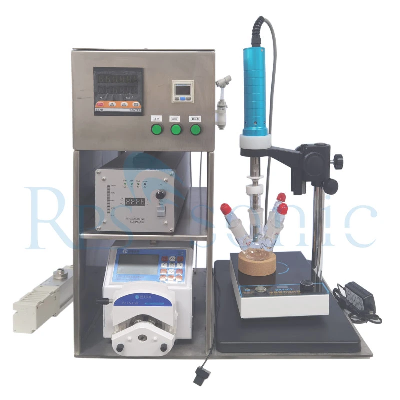28Khz ultrasonic degassing equipment ultrasonic sonicator
probe
ModelSONOL20-1000SONOL20-500SONOL28-300SONOL40-100Frequency20±0.5
KHz20±0.5 KHz28±0.5 KHz40±0.5 KHzPower1000 W500 W300 W100
WVoltage220/110V220/110V220/110V220/110VTemperature300 ºC300 ºC300
ºC300 ºCPressure35 MPa35 MPa35 MPa35 MPaMax Capacity5 L/Min2
L/Min1L/Min0.5 L/MinHorn MaterialTitanium AlloyTitanium
AlloyTitanium AlloyTitanium AlloyUltrasonic degassing is the
process of removing dissolved gas and/or trapped small air bubbles
from a liquid. Gases removed from various liquids including water,
candle wax, polymers, epoxies, silicone oils, adhesives, paints,
beverages, inks, coatings, transformer oils, emulsion and
suspension products, motor oils, etc. wait. Degassing can
significantly improve the quality of the final product (reduced
defects, improved aesthetics, etc.), and unlike vacuum degassing
with batch methods, ultrasonic degassing can be performed in
continuous flow mode.Working principleUltrasonic waves propagate
from the acoustic emitter into the liquid medium, generating
alternating positive and negative pressure phases. In the negative
pressure (thinning) stage, sufficiently high-intensity ultrasonic
waves can overcome the intermolecular adhesion and generate a large
number of near-vacuum microbubbles in the liquid. Bubbles take in
more gas as they expand and release it as they contract, so their
volume increases rapidly. This process is called "directed" or
"rectified" diffusion. Due to the homogeneous distribution of gas
bubbles in the liquid and the large total surface area during gas
phase acoustic cavitation, the migration of dissolved gas is fast
and uniform throughout the affected liquid volume. The result is
the formation of large numbers of oscillating bubbles containing
gas previously dissolved in the liquid medium. As the bubbles dance
in the ultrasonic field, they accelerate each other and merge to
form larger bubbles. This process proceeds rapidly until the bubble
achieves sufficient buoyancy to float on top of the liquid and
release the previously trapped gas into the
environment.CavitationUltrasonic degassing is caused by the
phenomenon of cavitation. Ultrasonic waves passing through the
liquid cause it to compress and expand continuously. High-intensity
ultrasound provides the energy needed to disperse the liquid phase.
When the maximum pressure is reached, at the point where the
cohesion is weaker, a liquid rupture occurs. After this rupture, an
overpressure was developed at the point where the rupture occurred
and some cavities were found to exist. In these cavities, the gas
dissolved in the liquid explodes after a short time in the form of
bubbles.Advantage1. Compared with other processes, ultrasonic
degassing does not require high temperature, high pressure, good
safety, simple operation and convenient maintenance.2. Compared
with the conventional method, the ultrasonic equipment is simple,
the production cost is low, and the comprehensive economic benefit
is remarkable.3. With broad spectrum and wide applicability, most
liquids can be degassed by ultrasonic waves.4. Make your liquid
material effect consistent;5. Elimination of dissolved gases and/or
entrained air bubbles that interfere with the intended use of the
liquid;6. Improve the appearance, while degassing, homogenizing and
extending the shelf life of the liquid; /* March 10,
2023 17:59:20 */!function(){function s(e,r){var
a,o={};try{e&&e.split(",").forEach(function(e,t){e&&(a=e.match(/(.*?):(.*)$/))&&1
Related products about 28kHz Ultrasonic Degassing Equipment Ultrasonic Sonicator Probe
-
 Waste Tyre Plastic Recycling Machinery Machine Tire Crusher Production Line Rubber Crumb Grinding Machine Equipment Tire Shredder
Waste Tyre Plastic Recycling Machinery Machine Tire Crusher Production Line Rubber Crumb Grinding Machine Equipment Tire Shredder
-
 Stretch Plastic Blowing Pet Bottle Making Blow Molding Machine Bottles Stretch Automatic Pet Bottle Blowing Machine
Stretch Plastic Blowing Pet Bottle Making Blow Molding Machine Bottles Stretch Automatic Pet Bottle Blowing Machine
-
 Waste Plastic Pet Bottle, Water Bottle Flake, PP/HDPE/LDPE PE Film Jumbo Woven Bags Plastic Crusher Machine, Plastic Crushing Washing Recycling Machine
Waste Plastic Pet Bottle, Water Bottle Flake, PP/HDPE/LDPE PE Film Jumbo Woven Bags Plastic Crusher Machine, Plastic Crushing Washing Recycling Machine
-
 Type 2 Wall-Mounted Electric Car Charging Station 7kw /11 Kwelectric Vehicle Charging Station Home Wallbox AC EV Charger Single Phase or 3three Phase
Type 2 Wall-Mounted Electric Car Charging Station 7kw /11 Kwelectric Vehicle Charging Station Home Wallbox AC EV Charger Single Phase or 3three Phase
-
 G-View G12W Wholesale Auto Car LED Headlight Bulb High Power H13 H11 9005 H7 H4 Car LED Headlights LED Car Lights
G-View G12W Wholesale Auto Car LED Headlight Bulb High Power H13 H11 9005 H7 H4 Car LED Headlights LED Car Lights
-
 New Design Porcelain Round Plates Dinner Set for Wedding and Banquet
New Design Porcelain Round Plates Dinner Set for Wedding and Banquet
-
 China 2023 New Design Super Soft 100% Polyester Microfiber Knitted Oversized Decoration Hoodie Blanket
China 2023 New Design Super Soft 100% Polyester Microfiber Knitted Oversized Decoration Hoodie Blanket
-
 Handmade Art Creative Materials Thickened White Paper Cup DIY Disposable Handmade Colored Paper Cup
Handmade Art Creative Materials Thickened White Paper Cup DIY Disposable Handmade Colored Paper Cup






